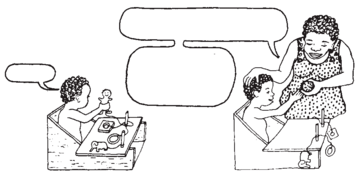Hesperian Health Guides
Particular Behavior Problems That Occur in Some Children with Disabilities
HealthWiki > Disabled Village Children > Chapter 40: Ways to Improve Learning and Behavior > Particular Behavior Problems That Occur in Some Children with Disabilities
Tantrums
Tantrums are fits of crying, screaming, and angry or destructive behavior. The child may try to break, throw, kick, bite, or in other ways damage anything or anyone within reach—sometimes including himself.
Tantrums can be frightening, both to the child and the family. After a tantrum begins, it is difficult to reason with the child and calm him. Punishment often makes it worse.
Children — including some children with disabilities — may learn to use tantrums to get what they want. Erica, in A Behavioral Approach to Learning and Improved Behavior, is one example. Here is another:
| Kwame has been left to play by himself. He tries to get Mama to come give him attention. | So Kwame has a trantrum. | Afraid he may hurt himself, Mama comes running to the rescue. Now Kwame has her full attention. |
 Ga-ga.
Not now, Kwame. I'm busy.
 |
 | |
 REFUSING ATTENTION HERE
AND GIVING HERE
ENCOURAGES BAD BEHAVIOR | ||
In this way children discover that tantrums get them what they want. To help a child have fewer tantrums, parents need to help the child find other, more acceptable ways of showing his wants and fears. And most important, parents need to reward the acceptable ways, and at the same time refuse to give the child attention when he is having a tantrum. Let’s look at how Kwame’s mother learned to do this:
| When Kwame acts nicely: | But when he has a tantrum: | |
 Ga-ga.
What is it, Kwame? Do you want to help Mama?
Here's some dough. You can help make bread, too!
 |
 Sorry, Kwame. I don't enjoy doing things with you when you scream. | |
 GIVING ATTENTION HERE
AND REFUSING IT HERE
REINFORCES GOOD BEHAVIOR | ||
Thus, by rewarding Kwame’s good behavior and by refusing to give attention to his demands when he does have tantrums, Kwame’s mama helped him learn that tantrums do not get him what he wants. At first he had more violent tantrums than ever. But when even these failed to give exciting results, little by little he stopped having tantrums. He found that other forms of communication gave more satisfying results.
Holding breath

“Not giving attention during a tantrum sounds very nice. But my child gets so angry, he stops breathing and turns blue! I can’t just do nothing!” But doing nothing is often the best way to prevent your child from holding his breath more often!
The child will not hurt himself by holding his breath. At worst, he will lose consciousness and begin to breathe normally, long before the lack of air causes any harm.
Once a child learns that holding her breath frightens and confuses her parents, she is likely to repeat it every time she gets angry at them. Many children without disabilities do this. We need to try not to show worry or concern when the child holds her breath and turns blue. Instead, we should wait until she gives up trying to frighten us and begins to breathe normally again. Then we can do something to show her how much we love her. But not while she is holding her breath!

Head banging, biting, and other self-harm
Children may do these things for the same reason they hold their breath — to frighten and punish their parents.
Sometimes, however, children with brain injury, epilepsy or severe cognitive delay may form habits of biting themselves, banging their heads, pulling out their hair or other self-destructive behavior.
 |
To stop a child who is hurting himself, hold him from behind tightly, but quietly, so that he does not see you and gets as little response from you as possible. |
Whatever the cause, acts of self-destruction cannot be ignored. Parents should look for the most simple and calm way possible to gently stop the child from injuring herself. For example, they can hold the child’s arms to keep her from biting herself.
However, often a behavioral approach helps solve these problems. Take care not to get excited or give the child extra attention when she hurts herself. At the same time, make every effort to reward positive behavior and to help the child gain self-confidence, learn new skills, play with toys and other children, and have friendly interaction with other people. Of course, some children’s mental ability will not allow much learning or play. Showing these children a lot of affection, hugging them, talking and singing to them, and doing things with them that they like, at times when they are not harming themselves, may help them to stop such acts. Rewarding a child when she stops a self-destructive act may help a child to not act that way so often. But be sure to reward and give the child even more attention at times she has not been harming herself. When possible, get advice from a child psychologist.


